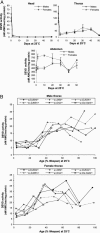Differential patterns of apoptosis in response to aging in Drosophila
- PMID: 16099837
- PMCID: PMC1189317
- DOI: 10.1073/pnas.0503374102
Differential patterns of apoptosis in response to aging in Drosophila
Abstract
Several lines of evidence suggest that programmed cell death may play a role in the aging process and the age-related functional declines of multicellular organisms. To pave the way for the use of Drosophila to rigorously test this hypothesis in a genetic model organism, this work examines the pattern of apoptosis in the adult fly during aging. The analysis across the lifespan of caspase activity and DNA fragmentation shows that apoptosis occurs in adult flies at all ages and that it is linked to physiological age. The results establish that under normal conditions, fly aging is coupled with a lifelong gradual increase of apoptosis within muscle cells and an activation of apoptosis in fat cells of old flies. The nervous system does not show signs of apoptosis. These time- and tissue-specific changes indicate that aging influences the levels and the nature of the cells that commit to apoptosis. The comparison with the apoptotic response to starvation and oxidative stresses strongly suggests that the lifelong increase in flight and leg muscles results from the accumulation of oxidative damage associated with aging. This finding presents an attractive mechanism to account for the decline of locomotor functions and muscle loss in the elderly and opens the way for the genetic analysis of sarcopenia in Drosophila.
Figures




References
-
- Ermak, G. & Davies, K. J. (2002) Mol. Immunol. 38, 713–721. - PubMed
-
- Ferri, K. F. & Kroemer, G. (2001) Bioessays 23, 111–115. - PubMed
-
- Kannan, K. & Jain, S. K. (2000) Pathophysiology 7, 153–163. - PubMed
-
- Norbury, C. J. & Zhivotovsky, B. (2004) Oncogene 23, 2797–2808. - PubMed
-
- Adams, J. M. (2003) Genes Dev. 17, 2481–2495. - PubMed
Publication types
MeSH terms
Substances
LinkOut - more resources
Full Text Sources
Medical
Molecular Biology Databases

